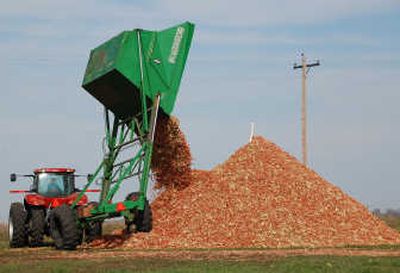Ethanol boom cools

SPIRITWOOD, N.D. — Harold Newman shuttered his financially foundering ethanol plant in October and then broke ground on one 10 times the size.
“It sounds crazy — but it appears to be the opportune time to do both,” he said.
Just a few months ago, Newman said, those who had invested in ethanol “made nothing but money.” But the boom has burst, profits have faded and ethanol isn’t the moneymaker it was. Many potential investors are now looking elsewhere.
Newman, 74, of Jamestown, in central North Dakota, made his fortune in the highway sign and billboard business, and to some extent, ethanol. He has weathered the erratic ethanol industry for a quarter-century and remains “absolutely bullish” on the corn-based fuel additive. Others are more skeptical.
“The ethanol industry is getting hit on both ends: Corn prices have gone way up and ethanol sale prices have gone down,” said Stephen Ham, an ethanol analyst at Standard & Poor’s in New York. “Clearly, the margins aren’t what they were a year ago. And being Wall Street types, you look at profitability.”
Ham has ranked top ethanol producing companies — Pacific Ethanol Inc., Aventine Renewable Energy Holdings Inc. and VeraSun Energy Corp. — at “neutral,” noting they have slid 62.6 percent, 54.3 percent and 37.1 percent, respectively year-to-date, while the S&P 500 index is up 3.1 percent.
Last month, in a sign of consolidation in the industry, Brookings, S.D.-based VeraSun announced a deal to acquire a smaller ethanol-producing competitor, US BioEnergy Corp. Analysts expect both companies to lose money in the fourth quarter.
The energy bill signed by President Bush in 2005 requires that 4 percent of gasoline sold or dispensed to U.S. motorists in 2007 be renewable fuel, such as ethanol and biodiesel.
Before that, more than half the ethanol plants in the U.S. were local-owned cooperatives. Only about 35 percent are today, overtaken by private equity funds and Wall Street types, said Geoff Cooper, a spokesman for the National Corn Growers Association in Chesterfield, Mo.
“Venture capital and Wall Street money came in this industry in 2005, and a lot of those plants broke ground funded by deep-pocket investors,” Cooper said.
Construction of new ethanol plants has slowed as high corn prices — driven by increased demand for ethanol as part of federal mandates for renewable fuels — have meant higher operating costs while the wholesale price of ethanol has dropped.
Newman said corn was fetching $3.60 a bushel in North Dakota Dec. 4, up from $2.28 a bushel in December 2005 while ethanol was at $1.98 a gallon, down from $2.53 a gallon in 2005.
Operators of E3 Biofuel, a Mead, Neb., plant, cited high corn costs and low ethanol prices among the factors in their decision to file for bankruptcy protection last week. The plant aimed at producing 25 million gallons of ethanol a year.
“A lot of the investors descended on the Corn Belt when the margins were very good — a lot of those folks have jumped ship, back into the things they were in before ethanol,” Cooper said. “The industry’s true colors are coming out — we’re seeing who is committed and who was the fly-by-nights.”
The private equity investment boom in ethanol plants has cooled in the past year, said Rick Kment, an ethanol analyst with DTN, an Omaha, Neb.-based agricultural market information company.
“I really see plant building in the near distant future to be in spurts,” Kment said. “The demand will continue to build, but it will build at a slower level.”
The U.S. has 131 ethanol refineries, 10 of which are expanding, and 72 more are being built, according to the Renewable Fuels Association.
Overproduction and a distribution network that has not kept pace with the flood of ethanol coming on the market hurt prices overall, said Ron Lamberty, a vice president of the Sioux Falls, S.D.-based American Coalition for Ethanol.
“The supply got there before demand, but the demand is coming up,” Lamberty said.
Frank Kirschenheiter, a rancher who led equity drives for an ethanol plant in southwest North Dakota that began producing fuel last year, said it’s becoming more difficult for grass-roots cooperatives to raise money for ethanol plants.
“New investors are a little more gun-shy,” Kirschenheiter said.
The $40 million raised for the Red Trail Energy plant came from more than 800 investors, a mix of North Dakota farmers, ranchers and businessmen with a minimum investment of $10,000.
“I don’t foresee anybody doing that again,” Kirschenheiter said.
The rising cost of corn and low ethanol prices forced the closure of Newman’s Alchem Ltd. ethanol plant in Grafton, in northeastern North Dakota. But he expects the 24-year-old plant — one of the first built in the U.S. — to reopen, as it did after ethanol demand lagged a decade ago.
Newman is also majority partner in the $260 million Spirit Ethanol plant, about a dozen miles east of Jamestown, and 120 miles southwest of his Alchem ethanol plant. The Spirit Ethanol plant, which could open next year, is part of a project called the Spiritwood Industrial Park that includes a $360 million coal-fired power plant to generate steam to cook corn into ethanol.
People are going to use ethanol, and U.S. motorists may not have a choice someday, Newman said.
“We still have over 60 percent of our fuel brought in from foreign interests,” he said. “I don’t think we can continue in that vein.”